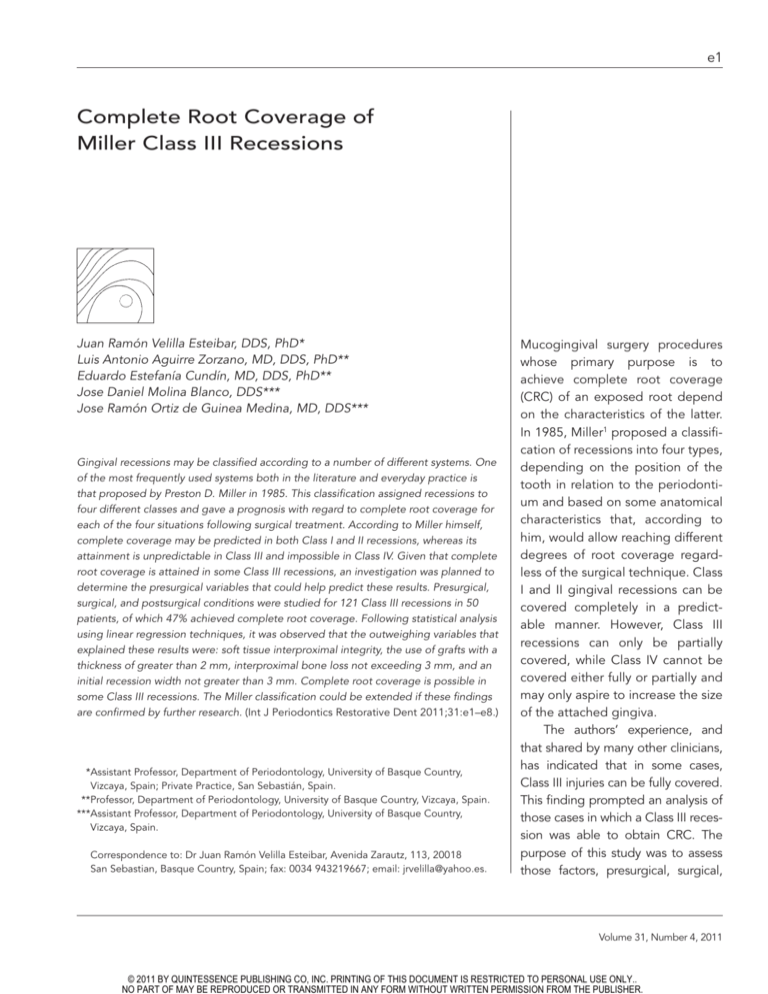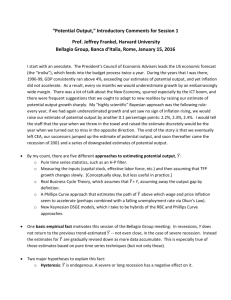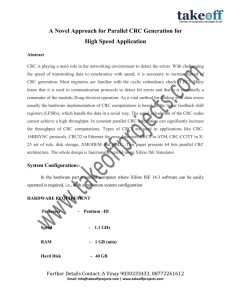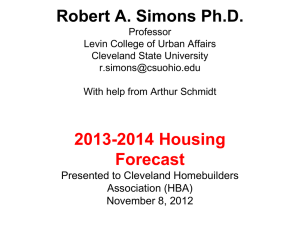Complete Root Coverage of Miller Class III Recessions
advertisement

e1 Complete Root Coverage of Miller Class III Recessions Juan Ramón Velilla Esteibar, DDS, PhD* Luis Antonio Aguirre Zorzano, MD, DDS, PhD** Eduardo Estefanía Cundín, MD, DDS, PhD** Jose Daniel Molina Blanco, DDS*** Jose Ramón Ortiz de Guinea Medina, MD, DDS*** Gingival recessions may be classified according to a number of different systems. One of the most frequently used systems both in the literature and everyday practice is that proposed by Preston D. Miller in 1985. This classification assigned recessions to four different classes and gave a prognosis with regard to complete root coverage for each of the four situations following surgical treatment. According to Miller himself, complete coverage may be predicted in both Class I and II recessions, whereas its attainment is unpredictable in Class III and impossible in Class IV. Given that complete root coverage is attained in some Class III recessions, an investigation was planned to determine the presurgical variables that could help predict these results. Presurgical, surgical, and postsurgical conditions were studied for 121 Class III recessions in 50 patients, of which 47% achieved complete root coverage. Following statistical analysis using linear regression techniques, it was observed that the outweighing variables that explained these results were: soft tissue interproximal integrity, the use of grafts with a thickness of greater than 2 mm, interproximal bone loss not exceeding 3 mm, and an initial recession width not greater than 3 mm. Complete root coverage is possible in some Class III recessions. The Miller classification could be extended if these findings are confirmed by further research. (Int J Periodontics Restorative Dent 2011;31:e1–e8.) *Assistant Professor, Department of Periodontology, University of Basque Country, Vizcaya, Spain; Private Practice, San Sebastián, Spain. **Professor, Department of Periodontology, University of Basque Country, Vizcaya, Spain. ***Assistant Professor, Department of Periodontology, University of Basque Country, Vizcaya, Spain. Correspondence to: Dr Juan Ramón Velilla Esteibar, Avenida Zarautz, 113, 20018 San Sebastian, Basque Country, Spain; fax: 0034 943219667; email: jrvelilla@yahoo.es. Mucogingival surgery procedures whose primary purpose is to achieve complete root coverage (CRC) of an exposed root depend on the characteristics of the latter. In 1985, Miller1 proposed a classification of recessions into four types, depending on the position of the tooth in relation to the periodontium and based on some anatomical characteristics that, according to him, would allow reaching different degrees of root coverage regardless of the surgical technique. Class I and II gingival recessions can be covered completely in a predictable manner. However, Class III recessions can only be partially covered, while Class IV cannot be covered either fully or partially and may only aspire to increase the size of the attached gingiva. The authors’ experience, and that shared by many other clinicians, has indicated that in some cases, Class III injuries can be fully covered. This finding prompted an analysis of those cases in which a Class III recession was able to obtain CRC. The purpose of this study was to assess those factors, presurgical, surgical, Volume 31, Number 4, 2011 © 2011 BY QUINTESSENCE PUBLISHING CO, INC. PRINTING OF THIS DOCUMENT IS RESTRICTED TO PERSONAL USE ONLY.. NO PART OF MAY BE REPRODUCED OR TRANSMITTED IN ANY FORM WITHOUT WRITTEN PERMISSION FROM THE PUBLISHER. e2 and postsurgical, more heavily involved with the achievement of CRC in Class III recessions. Method and materials This retrospective study was carried out by reviewing 121 Class III recessions in 50 patients, all of whom suffered from periodontal disease (Figs 1 to 3). Sample selection was performed by one single researcher based on data from the patients’ case histories as well as clinical and radiologic explorations. All patients were healthy aside from the periodontal disease for which they were being treated. Patients with previously treated recessions, recessions on teeth with pathologies or treatments (prosthodontics, root decay, cervical fillings, etc), and patients who were smokers or did not attend appointments for periodontal follow-up and maintenance care were excluded from this study. Variables and therapy Study variables were divided into presurgical, surgical, and postsurgical variables. Presurgical variables included: the tooth undergoing treatment, sex and age of the patient, interproximal bone loss (measured in mm from the cementoenamel junction to the bone crest), presence of grafted gingiva, recession width, recession depth, and the integrity of the interproximal soft tissue (Figs 1a and 1b, 2a and 2b, and 3a and 3b). Surgi- cal variables included the surgical technique used and graft thickness. The only postsurgical variable considered was creeping attachment. Pre- and postsurgical variables were analyzed and measured through clinical examination with PCP 11 periodontal probes (HuFriedy) and measurement of intraoral periodontal radiographs taken using a positioning device (XCP 2000, Denstply). All recessions were treated with free grafts obtained from the palate according to three different surgical techniques: the free gingival graft technique (as described by Holbrook and Ochsenbein2), the subepithelial connective tissue graft technique (as described by Langer and Langer3) (Figs 1c and 3c), and the connective tissue double pedicle graft technique (as described by Nelson4 and further modified by Harris5) (Fig 2c). Regardless of the surgical procedure used, all patients were instructed to follow the same postsurgical medical and prophylactic care, which included antibiotics (500 mg amoxicillin every 8 hours for 7 days) and anti-inflammatory medication (600 mg ibuprofen every 12 hours for 3 to 4 days). Patients were asked to refrain from any mechanical hygiene techniques in the treated area for the 4 weeks following surgery and were prescribed 0.12% chlorhexidine mouthwash twice a day during the 6 weeks after the procedure. In all cases, a professional hygiene procedure was performed in the area treated during week 8. Additionally, all cases were reviewed at weeks 1, 2, 4, 8, and 12 postsurgery. Patients were subsequently included in a 3-month recall periodontal maintenance program for the first year after the procedure, which varied over the following years depending on requirements. Evaluation of results from a root coverage point of view was carried out 3 months and 1 year after the procedure. Statistical analysis Statistical analysis of the data was carried out using the SPSS 11.0 software package for Windows (IBM). Both descriptive (contingency tables and bivariate correlation analysis) and predictive analyses (linear regression techniques and coefficients, curve fitting, partial and semipartial correlation, and colinearity diagnoses) were performed. Results Fifty patients (39 women, 11 men; mean age: 35.9 years) were selected for this study, in which 121 teeth were examined, including Class III recessions appearing in different teeth (Table 1). After surgical treatment, 57 of 121 recessions (47.11%) obtained CRC. At that point, differing variables were compared between the groups with and without CRC. Regarding presurgical variables, average recession depth and width (in mm), interproximal The International Journal of Periodontics & Restorative Dentistry © 2011 BY QUINTESSENCE PUBLISHING CO, INC. PRINTING OF THIS DOCUMENT IS RESTRICTED TO PERSONAL USE ONLY.. NO PART OF MAY BE REPRODUCED OR TRANSMITTED IN ANY FORM WITHOUT WRITTEN PERMISSION FROM THE PUBLISHER. e3 Figs 1a and 1b (left) Clinical and (right) radiographic views of a Class III recession at the maxillary right central incisor. The extrusion can be observed. Fig 1c (bottom left) Treatment using the Langer technique. Fig 1d (below) Final result: CRC was obtained. Fig 2a (left) Clinical view of Class III recessions at the mandibular central incisors. Fig 2b (right) Baseline radiograph showing interproximal bone loss. Fig 2c (left) Treatment using a palatal connective tissue graft. Fig 2d (right) Results after surgical treatment. CRC can be observed. Volume 31, Number 4, 2011 © 2011 BY QUINTESSENCE PUBLISHING CO, INC. PRINTING OF THIS DOCUMENT IS RESTRICTED TO PERSONAL USE ONLY.. NO PART OF MAY BE REPRODUCED OR TRANSMITTED IN ANY FORM WITHOUT WRITTEN PERMISSION FROM THE PUBLISHER. e4 Fig 3a (left) Clinical view of a Class III recession at the maxillary right central incisor. Integrity of the interproximal soft tissue was not preserved. Fig 3b (right) Radiograph showing interproximal bone loss. Fig 3c (left) Treatment using the Langer technique. Fig 3d (right) Results after surgical treatment. CRC was achieved. Table 1 Distribution of examined teeth No. examined Maxilla % Central incisor 2 1.65 Lateral incisor 6 4.96 19 15.70 First premolar 7 5.79 Second premolar 1 0.83 Canine Mandible Central incisor 35 28.93 Lateral incisor 19 15.70 Canine 15 12.40 First premolar 10 8.26 Second premolar 6 4.96 First molar 1 0.83 The International Journal of Periodontics & Restorative Dentistry © 2011 BY QUINTESSENCE PUBLISHING CO, INC. PRINTING OF THIS DOCUMENT IS RESTRICTED TO PERSONAL USE ONLY.. NO PART OF MAY BE REPRODUCED OR TRANSMITTED IN ANY FORM WITHOUT WRITTEN PERMISSION FROM THE PUBLISHER. e5 Table 2 Influence of surgical procedure Procedure used CRC % total coverage 6% 7% 80.55% Subepithelial connective tissue graft3 82% 86% 84% 74.40% Free gingival graft2 11% 8% 9% 80.00% Study of the optimal regression model according to the most predictive variables Unstandardized coefficients % total cases 7% Connective tissue double pedicle graft4,5 Table 3 No CRC Standardized coefficient P Model B Standard error Beta t Constant 0.141 0.197 0.717 Soft tissue integrity –0.508 0.076 –0.498 –6.666 Interproximal bone loss 0.103 0.031 0.246 3.304 Graft thickness –0.231 0.079 –0.204 –2.931 Recession width 0.104 0.040 0.184 2.611 soft tissue loss, and interproximal bone loss were noticeably lower in the CRC group. Similarly, in 68% of patients in the CRC group, integrity of the interproximal soft tissue was observed, whereas only 14% of those without CRC presented this characteristic. Regarding surgical variables, a higher rate of cases without CRC was found when a connective tissue graft of at least 2 mm in thickness was not used (34% .475 Colinearity statistics Correlations Zeroorder Partial Semipartial Tolerance –0.526 –0.455 0.834 1.199 0.446 0.293 0.225 0.839 1.191 .004 –0.190 –0.263 –0.200 0.957 1.045 0.236 0.780 0.937 1.067 .000 –0.555 .001 .010 0.195 vs 18%). The Langer3 technique was the most frequently used procedure out of the three employed. However, no clear differences in the final result were observed among procedures, as shown in Table 2. With regard to the only postsurgical variable analyzed (creeping attachment), hardly any differences were observed between the group that attained CRC (35%) and the one that did not (33%). VIF To take into account the joint action of the different variables to obtain a predictive model, a multiple linear regression model is required. Of the several models analyzed, the model shown in Table 3 is the one that best explains the patients in this study. This is confirmed by the goodness of fit, presented in Table 4. According to this model, integrity of the interproximal soft tissue, minimal interproximal bone Volume 31, Number 4, 2011 © 2011 BY QUINTESSENCE PUBLISHING CO, INC. PRINTING OF THIS DOCUMENT IS RESTRICTED TO PERSONAL USE ONLY.. NO PART OF MAY BE REPRODUCED OR TRANSMITTED IN ANY FORM WITHOUT WRITTEN PERMISSION FROM THE PUBLISHER. e6 Table 4 Goodness of fit Model R R2 Adjusted R2 Standard error of the estimate 0.679* 0.461 0.442 0.374 *Constant predictive variable: interproximal soft tissue, interproximal bone loss, graft thickness, recession width. loss, thickness of the graft used, and minimal width of the existing recession are the outweighing variables when CRC is sought. When these results were transferred to the current study, it was observed that in cases where the integrity of the interproximal soft tissue was preserved, a graft of more than 2 mm in thickness was used, recession width was 3 mm or less, and bone loss, as measured on the radiograph, was not above 3 mm, the success rate was 100%. This means that all cases treated under these circumstances achieved CRC (Figs 1d, 2d, and 3d). Discussion In the literature, there are not many publications—and even fewer studies—dealing with the treatment of Miller Class III recessions, most of which focused on the comparison of techniques or the evaluation of results obtained by new procedures and mainly addressed Class I and II recessions. This may seem reasonable, since these two types of recessions are likely to yield the most satisfactory results in terms of CRC attainment. It is possible that the unpredictability of success in treating these types of recessions (Class III) could have been a detrimental factor when designing studies on CRC, and it would be unfavorable to do so in principle. Therefore, the limited amount of research published on Class III recessions is not addressed to determine actual CRC, but rather to ascertain the maximum degree of root coverage obtained by different procedures.5–9 In 1996, Fombellida et al6 treated 25 Class III recessions using the Holbrook and Ochsenbein technique2 and 25 using the Sullivan and Atkins technique.10 This study did not evaluate CRC achievement, but rather increase in vestibular insertion, which was 1.86 mm using the Sullivan and Atkins technique and 2.52 mm with the Holbrook and Ochsenbein technique, for an average initial recession depth of 5.40 mm. In the current investigation, the 11 cases treated with the Holbrook and Ochsenbein technique presented a mean initial recession depth of 3.18 mm and a mean residual recession of 0.64 mm. In other words, the increase in vestibular insertion was 2.54 mm, which means that both studies obtained practically the same results. In the sample investigated, the statistical analysis performed found four variables that, when analyzed jointly, showed their relevance to CRC prediction in Class III recessions. These variables are: the presence of interproximal soft tissue integrity, an interproximal reduced bone loss, using a graft greater than 2 mm in thickness, and a minimum width of the recession. Analyzing these results concerning gained root coverage, the authors noted that the achievement of CRC in Miller Class III recessions is not only possible, but also predictable if the requirements for the aforementioned parameters are fulfilled. Most factors described have been mentioned in the limited literature existing on the subject. For instance, Blanes and Allen7 referred to CRC in Class I, II, and III recessions. They described a new surgical technique that presented excellent results for Class I and II recessions because of the increased blood supply it provided. With regard to Class III recessions, they stated that the achievement of The International Journal of Periodontics & Restorative Dentistry © 2011 BY QUINTESSENCE PUBLISHING CO, INC. PRINTING OF THIS DOCUMENT IS RESTRICTED TO PERSONAL USE ONLY.. NO PART OF MAY BE REPRODUCED OR TRANSMITTED IN ANY FORM WITHOUT WRITTEN PERMISSION FROM THE PUBLISHER. e7 CRC was possible in the least severe cases in which the interproximal soft tissue integrity remained. This conclusion agrees to some extent with the current one. In any case, their investigation should be considered a pilot study, since the authors themselves acknowledged the need for further research work using a wider sample. The study by Fombellida in 200211 analyzed the “vascular supply” as a factor having great influence in the prediction of root coverage success. According to the author, a positive balance between the vascularized and nonvascularized areas of the surgical field yields better results in terms of CRC, even in those less favorable cases, such as Miller Class III recessions. This partly matches the current findings, which identified recession width as one of the factors to take into account for predictability of success, since, in a surgical field, such a nonvascular area is mostly dependent on the initial width of the existing recession. In the study by Fombellida,11 the author identified further important factors for treatment success predictability: limited interproximal bone loss, undamaged interproximal soft tissue, and suitable thickness of the palatal graft obtained. These conclusions corroborate the current findings. In addition, regarding the interproximal tissue, the width of the graft should be considered important because it will represent a greater contribution to the vascular graft, as well as the interradicular distance. It seems likely that the attainment of CRC in cases traditionally classified as Miller Class III and considered “less severe” would not be an illusion and would not happen randomly, but rather be a response to some preoperative clinical variables and intraoperative measures. The limitations of retrospective studies should not be ignored. Consequently, it would be reasonable to wait for future prospective studies that could confirm these findings. 8. Villaverde Ramírez G, Blanco Carrión J, Ramos Barbosa I, Bascones Ilundain J, Bascones Martínez A. Tratamiento de las recesiones gingivales mediante injertos de tejido conectivo (Técnica de injerto conectivo subepitelial). Resultados tras cinco años de evolución. Av Periodoncia 2000;12:35–42. 9. Azzi R, Etienne D, Sauvan JL, Miller PD. Root coverage and papilla reconstruction in Class IV recession: A case report. Int J Periodontics Restorative Dent 1999;19:449–455. 10. Sullivan HC, Atkins JH. Free autogenous gingival grafts. I. Principles of successful grafting. Periodontics 1968;6:121–129. 11. Fombellida F. El pronóstico del cubrimiento radicular en el autoinjerto de encía queratinizado. Estudio de las diferentes variables anatómicas. Periodoncia y Osteointegración 2002;12:121–132. References 1. Miller PD Jr. A classification of marginal tissue recession. Int J Periodontics Restorative Dent 1985;5:8–13. 2. Holbrook T, Ochsenbein C. Complete coverage of the denuded root surface with a one-stage gingival graft. Int J Periodontics Restorative Dent 1983;3:9–27. 3. Langer B, Langer L. Subepithelial connective tissue graft technique for root coverage. J Periodontol 1985;56:715–720. 4. Nelson SW. The subpedicle connective tissue graft. A bilaminar reconstructive procedure for the coverage of denuded root surfaces. J Periodontol 1987;58: 95–102. 5. Harris RJ. The connective tissue and partial thickness double pedicle graft: A predictable method of obtaining root coverage. J Periodontol 1992;63:477–486. 6. Fombellida Cortázar F, Martos Molino F, Sáez Domínguez JR, Esparza Muñoz H, Goiriena de Gandarias FJ. Estudio comparativo de la eficacia clínica de autoinjerto libre de encía en la recesión del tejido blando marginal clase III de Miller. Av Periodoncia 1996;8:147–152. 7. Blanes RJ, Allen EP. The bilateral pedicle flap-tunnel technique: A new approach to cover connective tissue grafts. Int J Periodontics Restorative Dent 1999; 19:471–479. Volume 31, Number 4, 2011 © 2011 BY QUINTESSENCE PUBLISHING CO, INC. PRINTING OF THIS DOCUMENT IS RESTRICTED TO PERSONAL USE ONLY.. NO PART OF MAY BE REPRODUCED OR TRANSMITTED IN ANY FORM WITHOUT WRITTEN PERMISSION FROM THE PUBLISHER.







